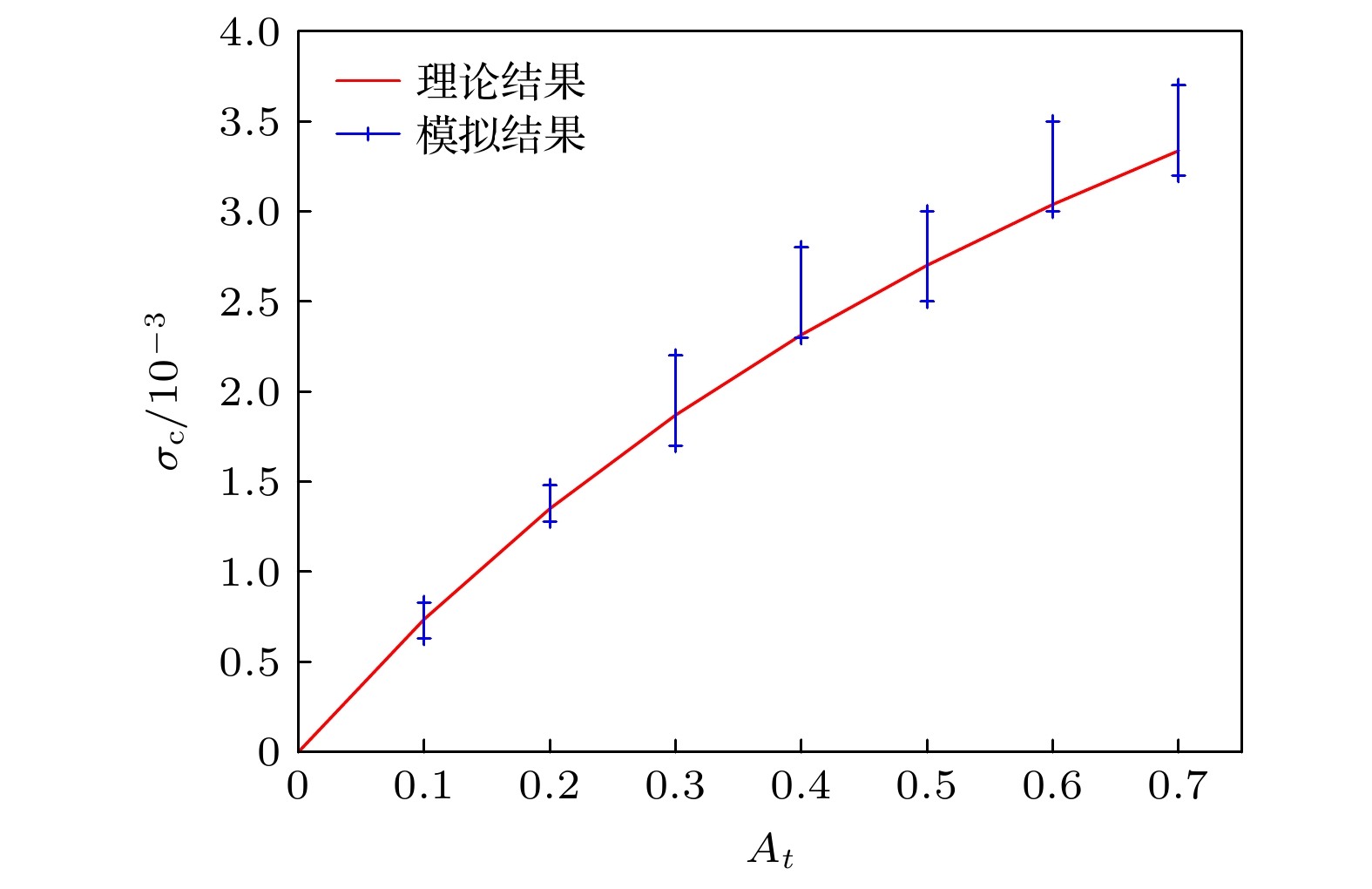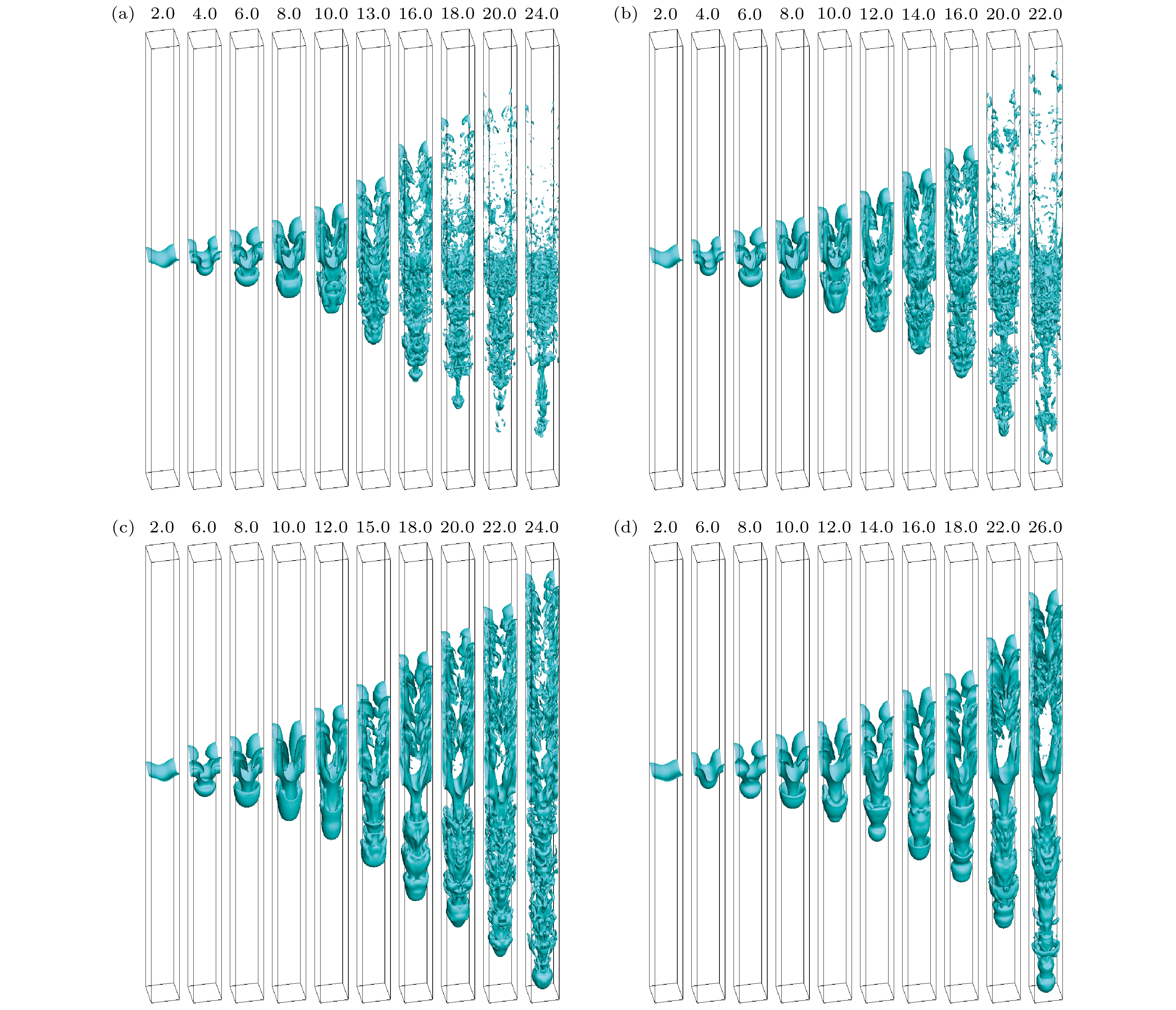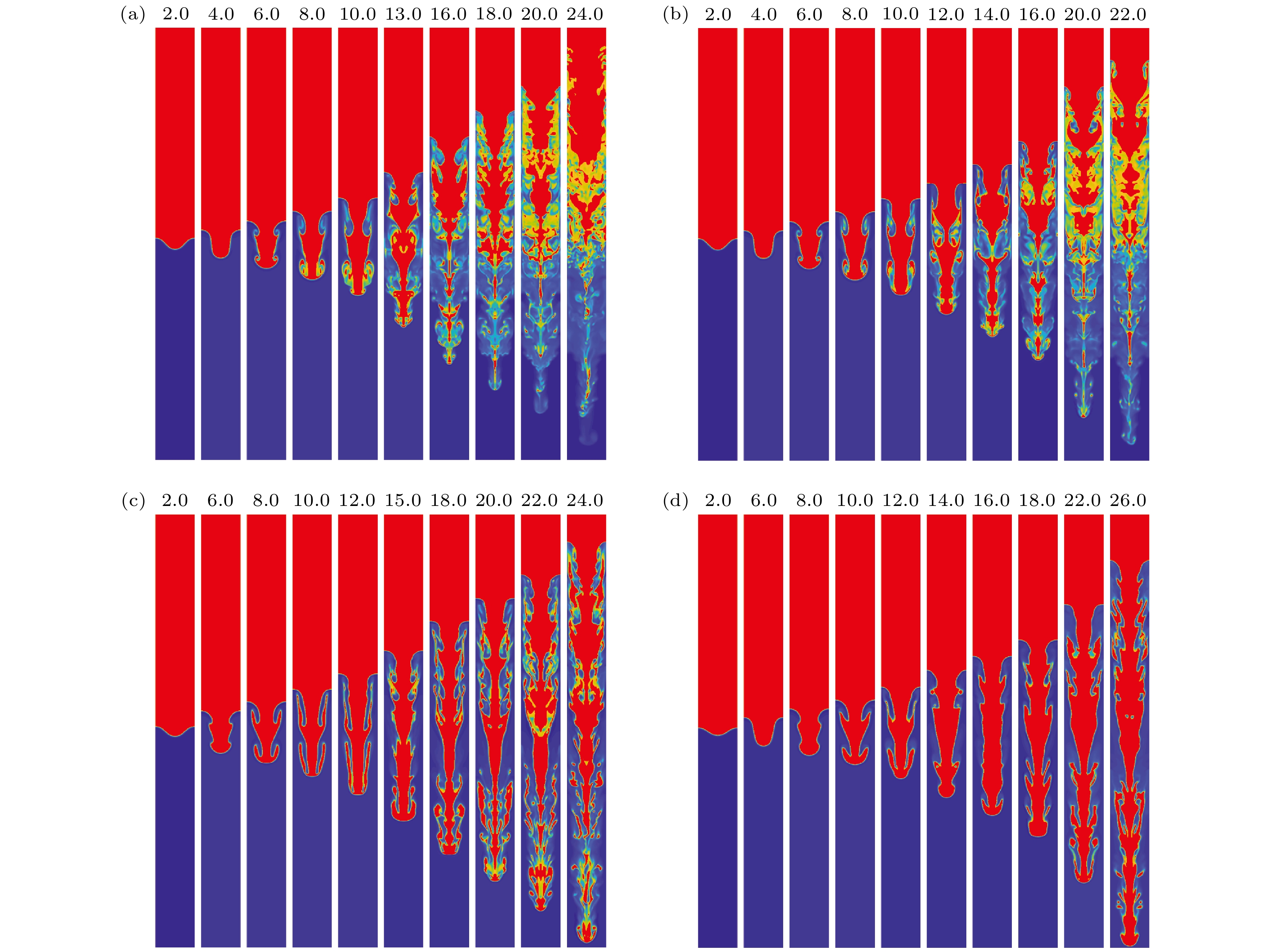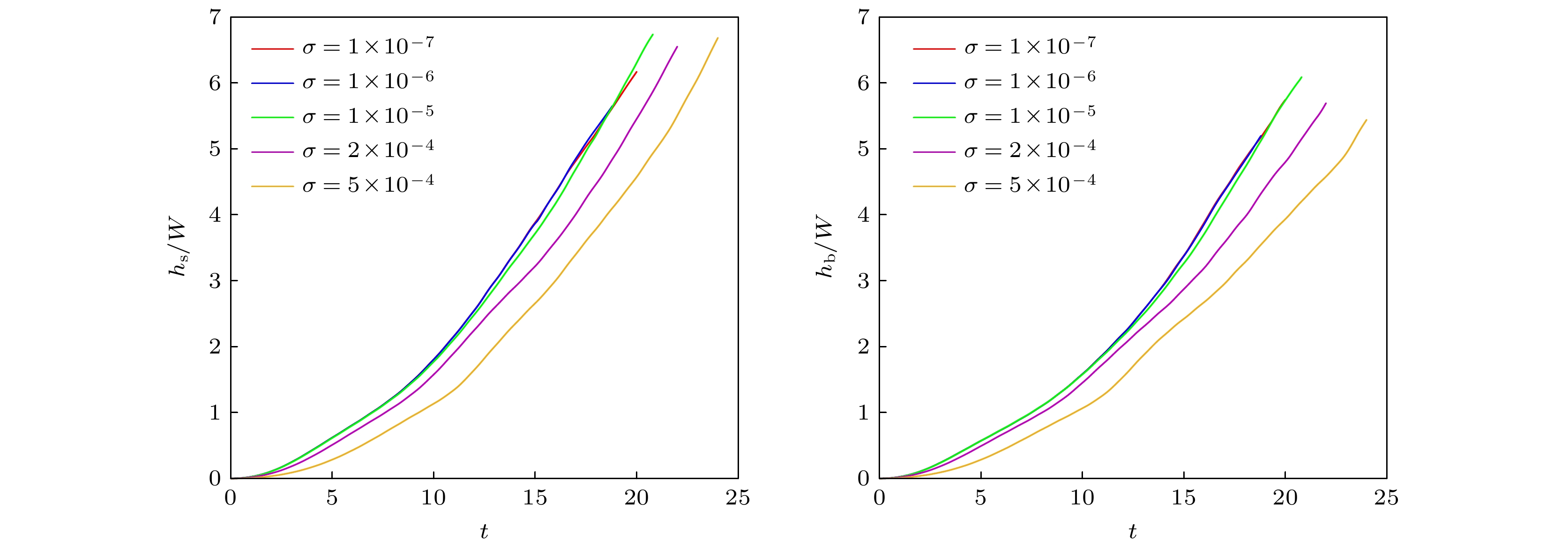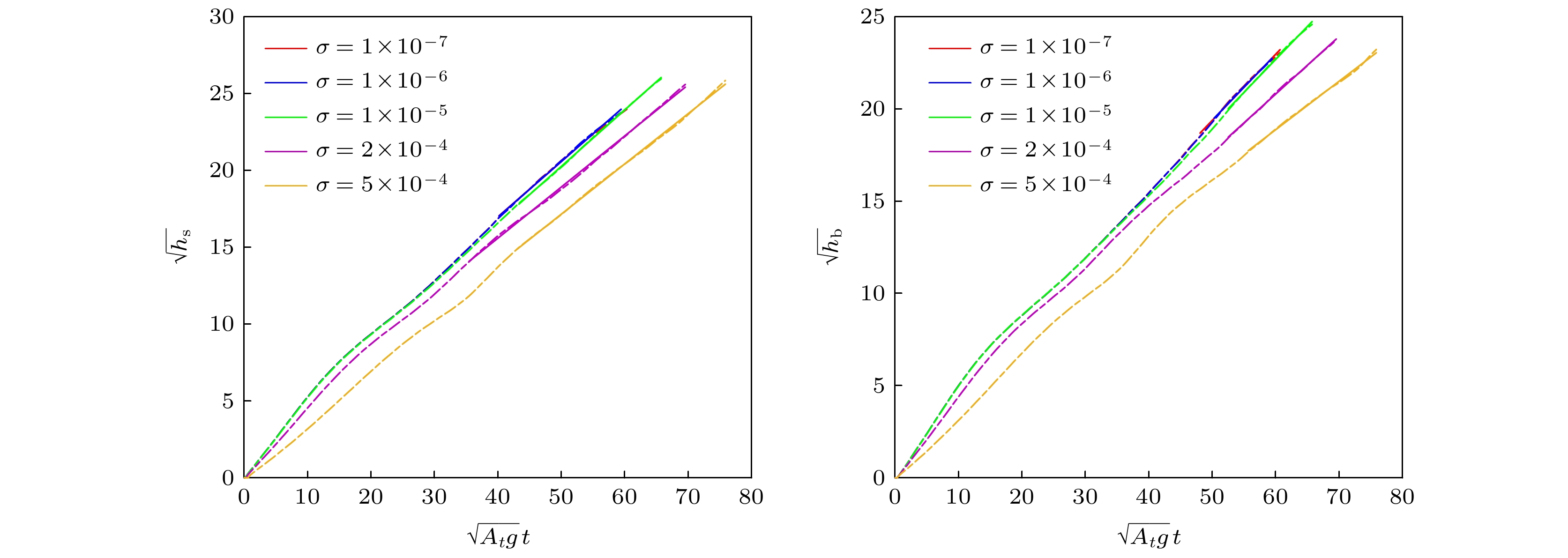-
采用介观格子Boltzmann方法模拟界面张力作用下三维流体界面的Rayleigh-Taylor (RT)不稳定性的增长过程, 主要分析表面张力对流体界面动力学行为及尖钉和气泡后期增长的影响机制. 首先发现三维 RT不稳定性的发生存在临界表面张力(
$\sigma_{\rm{c}}$ ), 其值随着流体Atwood数的增大而增大, 且数值预测值与理论分析结果${\sigma_{\rm{c}}}= {{({{\rho_{\rm{h}}}-{\rho_{\rm{l}}}})g}}/{{{k^2}}}$ 一致. 另外, 随着表面张力的增大, 不稳定性演化过程中界面卷吸程度和结构复杂性逐渐减弱, 系统中界面破裂形成离散液滴的数目也显著减少. 相界面的后期动力学行为也从非对称发展转向始终保持关于中轴线对称. 尖钉与气泡振幅在表面张力较小时对其变化不显著, 当表面张力增大到一定值后, 可以有效地抑制尖钉与气泡振幅的增长. 进一步发现, 高雷诺数三维RT不稳定性在不同表面张力下均经历4个不同的发展阶段: 线性阶段、饱和速度阶段、重加速和混沌混合阶段. 尖钉与气泡在饱和速度阶段以近似恒定的速度增长, 其渐进速度的值与修正的势流理论模型结果一致. 受非线性Kelvin-Helmholtz旋涡的剪切作用, 尖钉与气泡随后的增长被加速, 导致在重加速阶段的演化速度超过势流模型的解析解. 重加速阶段不能持续发展下去, 尖钉与气泡在不稳定性后期的增长速度会随时间上下波动, 这表明不稳定性的演化进入了混沌混合阶段. 通过数值分析, 证实了三维RT不稳定性在后期的混沌混合阶段具有二次增长的规律, 并且尖钉与气泡增长率总体上随着表面张力的增大而逐渐减少.-
关键词:
- Rayleigh-Taylor不稳定性 /
- 格子Boltzmann方法 /
- 界面张力 /
- 雷诺数 /
- 湍流混合
In this paper, the development of three-dimensional fluid interfacial Rayleigh-Taylor (RT) instability coupled with the surface tension was numerically studied using the mesoscopic lattice Boltzmann method. We mainly analyzed the influence of surface tension on fluid interfacial dynamics and spike/bubble late-time growth. The numerical experiments show that there exists the critical surface tension ($\sigma_{\rm{c}}$ ) in the three-dimensional RT instability, above which the RT phenomenon does not appear and below which it would take place. It is found that the critical surface tension increases with the fluid Atwood number and the corresponding numerical predictions show good agreements with those of the theoretical analysis${\sigma_{\rm{c}}}= {{({{\rho_{\rm{h}}}-{\rho_{\rm{l}}}})g}}/{{{k^2}}}$ . In addition, we can find that increasing surface tension reduces the roll-up of the interface and the complexity of interfacial structure, also preventing the breakup of the interface into the individual droplets. The late-time dynamics of phase interface change from the asymmetric development to the symmetry with respect to the middle axis. When the surface tension is sufficiently low, the spike and bubble amplitudes almost no longer change with it, and further increasing the surface tension can slow down the growth of the spike and bubble amplitudes. Furthermore, we can observe that the development of the high-Reynolds-number RT instability under different surface tensions can also be divided into four distinct stages, including the linear growth, saturated velocity growth, reacceleration, and chaotic mixing. The spike and bubble grow with approximately constant velocities at the saturated stage and their asymptotic values are consistent with those of the modified potential flow theory. In the following, the spike and bubble driven by the increasing Kelvin-Helmholtz vortices are accelerated such that their evolutional velocities exceed the solutions of the potential flow model at the reacceleration stage. The reacceleration stage cannot last infinitely and the spike and bubble velocities at the late time fluctuate with time, implying that the growth of the RT instability enters into the chaotic mixing stage. By numerical analysis, we demonstrate that the three-dimensional RT instability at the chaotic mixing stage has a quadratic growth and also report that the spike and bubble growth rates decrease with the surface tension in general.-
Keywords:
- Rayleigh-Taylor instability /
- lattice Boltzmann method /
- surface tension /
- Reynolds number /
- turbulent mixing
[1] Zhou Y 2017 Phys. Rep. 720
[2] Boffetta G, Mazzino A 2017 Annu. Rev. Fluid Mech. 49 119
 Google Scholar
Google Scholar
[3] Rayleigh L 1883 Proc. London Math. Soc. 14 170
[4] Taylor G I 1950 Proc. R. Soc. London Ser. A 201 192
[5] Lewis D J 1950 Proc. R. Soc. London Ser. A 202 81
 Google Scholar
Google Scholar
[6] Waddell J T, Niederhaus C E, Jacobs J W 2001 Phys. Fluids 13 1263
 Google Scholar
Google Scholar
[7] Goncharov V N 2002 Phys. Rev. Lett. 88 134502
 Google Scholar
Google Scholar
[8] Sohn S I 2009 Phys. Rev. E 80 055302(R
 Google Scholar
Google Scholar
[9] Glimm J, Li X L, Lin A D 2002 Acta Math. Appl. Sin. 18 1
[10] Wilkinson J P, Jacobs J W 2007 Phys. Fluids 19 124102
 Google Scholar
Google Scholar
[11] Ramaprabhu P, Dimonte G, Young Y N, Calder A C, Fryxell B 2006 Phys. Rev. E 74 066308
 Google Scholar
Google Scholar
[12] Bian X, Aluie H, Zhao D X, Zhang H S, Livescu D 2020 Physica D 403 132250
 Google Scholar
Google Scholar
[13] Ramaprabhu P, Dimonte G, Woodward P, Fryer C, Rochefeller G, Muthuraman K, Lin P H, Jayaraj J 2012 Phys. Fluids 24 074107
 Google Scholar
Google Scholar
[14] Wei T, Livescu D 2012 Phys. Rev. E 86 046405
 Google Scholar
Google Scholar
[15] Hu Z X, Zhang Y S, Tian B L, He Z W, Li L 2019 Phys. Fluids 31 104108
 Google Scholar
Google Scholar
[16] 李德梅, 赖惠林, 许爱国, 张广财, 林传栋, 甘延标 2018 物理学报 67 080501
 Google Scholar
Google Scholar
Li D M, Lai H L, Xu A G, Zhang G C, Lin C D, Gan Y B 2018 Acta Phys. Sin. 67 080501
 Google Scholar
Google Scholar
[17] Liang H, Li Q X, Shi B C, Chai Z H 2016 Phys. Rev. E 93 033113
 Google Scholar
Google Scholar
[18] 胡晓亮, 梁宏, 王会利 2020 物理学报 69 044701
 Google Scholar
Google Scholar
Hu X L, Liang H, Wang H L 2020 Acta Phys. Sin. 69 044701
 Google Scholar
Google Scholar
[19] Liang H, Xia Z H, Huang H W 2021 Phys. Fluids 33 082103
 Google Scholar
Google Scholar
[20] Daly B J 1969 Phys. Fluids 12 1340
 Google Scholar
Google Scholar
[21] Zhang R Y, He X Y, Chen S Y 2000 Comput. Phys. Commun. 129 121
 Google Scholar
Google Scholar
[22] Young Y N, Ham F E 2006 J. Turbul. 7 71
 Google Scholar
Google Scholar
[23] Matsuoka C 2009 Phys. Fluids 21 092107
 Google Scholar
Google Scholar
[24] Sohn S I 2009 Physical Review E 80 055302(R
[25] 夏同军, 董永强, 曹义刚 2013 物理学报 62 214702
 Google Scholar
Google Scholar
Xia T J, Dong Y Q, Cao Y G 2013 Acta. Phys. Sin. 62 214702
 Google Scholar
Google Scholar
[26] 黄皓伟, 梁宏, 徐江荣 2021 物理学报 70 114701
 Google Scholar
Google Scholar
Huang H W, Liang H, Xu J R 2021 Acta Phys. Sin. 70 114701
 Google Scholar
Google Scholar
[27] Guo Z L, Shu C 2013 Lattice Boltzmann Method and its Applications in Engineering (Singapore: World Scientific Publishing Company) pp239–284
[28] Wang H L, Yuan X L, Liang H, Chai Z H, Shi B C 2019 Capillarity 2 33
 Google Scholar
Google Scholar
[29] Liang H, Hu X L, Huang X F, Xu J R 2019 Phys. Fluids 31 112104
 Google Scholar
Google Scholar
[30] Liang H, Shi B C, Guo Z L, Chai Z H 2014 Phys. Rev. E 89 053320
 Google Scholar
Google Scholar
[31] Liang H, Shi B C, Chai Z H 2017 Comput. Math. Appl. 73 1524
 Google Scholar
Google Scholar
[32] d’Humieres D, Ginzburg I, Krafczyk M, Lallemand P, Luo L S 2002 Philos. Trans. R. Soc. London, Ser. A 360 437
 Google Scholar
Google Scholar
[33] He X Y, Chen S Y, Zhang R Y 1999 J. Comput. Phys. 152 642
 Google Scholar
Google Scholar
[34] Abarzhi S I, Gorobets A, Sreenivasan K R 2005 Phys. Fluids 17 081705
 Google Scholar
Google Scholar
[35] Olson D H, Jacobs J W 2009 Phys. Fluids 21 034103
 Google Scholar
Google Scholar
-
图 3 表面张力对高雷诺数三维单模RT不稳定性相界面演化的影响,
$ Re = 5000 $ ,$ A_t = 0.1 $ (a)$ \sigma = 1\times10^{-6} $ ; (b)$\sigma = 1\times $ $ 10^{ - 5}$ ; (c)$ \sigma = 2\times10^{ - 4} $ ; (d)$ \sigma = 5\times10^{ - 4} $ Fig. 3. Effect of the surface tension on the evolution of phase interface in three-dimensional single-mode RT instability with high Reynolds number,
$ Re = 5000 $ ,$ A_t = 0.1 $ : (a)$ \sigma = 1\times10^{-6} $ ; (b)$ \sigma = 1\times10^{ - 5} $ ; (c)$ \sigma = 2\times10^{ - 4} $ ; (d)$ \sigma = 5\times10^{ - 4} $ .图 4 表面张力对高雷诺数三维单模RT不稳定性的对角平面(x = y平面)的相界面演化的影响,
$ Re = 5000 $ ,$ A_t = 0.1 $ (a)$\sigma = $ $ 1\times10^{ - 6}$ ; (b)$ \sigma = 1\times10^{ - 5} $ ; (c)$ \sigma = 2\times10^{ - 4} $ ; (d)$ \sigma = 5\times10^{ - 4} $ Fig. 4. Effect of the surface tension on the evolution of phase interface in the diagonal plane of three-dimensional single-mode RT instability with high Reynolds number,
$ Re = 5000 $ ,$ A_t = 0.1 $ : (a)$ \sigma = 1\times10^{ - 6} $ ; (b)$ \sigma = 1\times10^{ - 5} $ ; (c)$ \sigma = 2\times10^{ - 4} $ ; (d)$\sigma = $ $ 5\times10^{ - 4}$ .图 6 表面张力对随时间演化的尖钉(左)和气泡(右)增长速度的影响. 黑色和蓝色虚线分别表示修正的势能模型所预测尖钉与气泡渐进速度在
$ \sigma = 1\times10^{ - 5} $ $ \sigma = 5\times10^{ - 4} $ 时的解析解Fig. 6. Influence of surface tension on the time evolutions of spike (left) and bubble (right) growth velocities. The black and blue dotted lines represent the analytical solutions of the spike and bubble asymptotic velocities from the modified potential flow model at
$ \sigma = 1\times10^{ - 5} $ and$ \sigma = 5\times10^{ - 4} $ .图 7 不同界面张力下三维RT不稳定性中尖钉(左)与气泡(右)振幅的开方
$ \sqrt{h_{{\rm{s, b}}}} $ 与演化时间$ \sqrt{gA_t}t $ 的关系曲线, 实线表示在后期混沌混合阶段的线性拟合结果Fig. 7. Relations between the square roots of the spike and bubble amplitudes
$ \sqrt{h_{{\rm{s, b}}}} $ and the time$ \sqrt{g{A_t}}t $ in the three-dimensional RT instability with different surface tensions. The solid lines represent the linear fitting results at the late-time chaotic mixing stage. -
[1] Zhou Y 2017 Phys. Rep. 720
[2] Boffetta G, Mazzino A 2017 Annu. Rev. Fluid Mech. 49 119
 Google Scholar
Google Scholar
[3] Rayleigh L 1883 Proc. London Math. Soc. 14 170
[4] Taylor G I 1950 Proc. R. Soc. London Ser. A 201 192
[5] Lewis D J 1950 Proc. R. Soc. London Ser. A 202 81
 Google Scholar
Google Scholar
[6] Waddell J T, Niederhaus C E, Jacobs J W 2001 Phys. Fluids 13 1263
 Google Scholar
Google Scholar
[7] Goncharov V N 2002 Phys. Rev. Lett. 88 134502
 Google Scholar
Google Scholar
[8] Sohn S I 2009 Phys. Rev. E 80 055302(R
 Google Scholar
Google Scholar
[9] Glimm J, Li X L, Lin A D 2002 Acta Math. Appl. Sin. 18 1
[10] Wilkinson J P, Jacobs J W 2007 Phys. Fluids 19 124102
 Google Scholar
Google Scholar
[11] Ramaprabhu P, Dimonte G, Young Y N, Calder A C, Fryxell B 2006 Phys. Rev. E 74 066308
 Google Scholar
Google Scholar
[12] Bian X, Aluie H, Zhao D X, Zhang H S, Livescu D 2020 Physica D 403 132250
 Google Scholar
Google Scholar
[13] Ramaprabhu P, Dimonte G, Woodward P, Fryer C, Rochefeller G, Muthuraman K, Lin P H, Jayaraj J 2012 Phys. Fluids 24 074107
 Google Scholar
Google Scholar
[14] Wei T, Livescu D 2012 Phys. Rev. E 86 046405
 Google Scholar
Google Scholar
[15] Hu Z X, Zhang Y S, Tian B L, He Z W, Li L 2019 Phys. Fluids 31 104108
 Google Scholar
Google Scholar
[16] 李德梅, 赖惠林, 许爱国, 张广财, 林传栋, 甘延标 2018 物理学报 67 080501
 Google Scholar
Google Scholar
Li D M, Lai H L, Xu A G, Zhang G C, Lin C D, Gan Y B 2018 Acta Phys. Sin. 67 080501
 Google Scholar
Google Scholar
[17] Liang H, Li Q X, Shi B C, Chai Z H 2016 Phys. Rev. E 93 033113
 Google Scholar
Google Scholar
[18] 胡晓亮, 梁宏, 王会利 2020 物理学报 69 044701
 Google Scholar
Google Scholar
Hu X L, Liang H, Wang H L 2020 Acta Phys. Sin. 69 044701
 Google Scholar
Google Scholar
[19] Liang H, Xia Z H, Huang H W 2021 Phys. Fluids 33 082103
 Google Scholar
Google Scholar
[20] Daly B J 1969 Phys. Fluids 12 1340
 Google Scholar
Google Scholar
[21] Zhang R Y, He X Y, Chen S Y 2000 Comput. Phys. Commun. 129 121
 Google Scholar
Google Scholar
[22] Young Y N, Ham F E 2006 J. Turbul. 7 71
 Google Scholar
Google Scholar
[23] Matsuoka C 2009 Phys. Fluids 21 092107
 Google Scholar
Google Scholar
[24] Sohn S I 2009 Physical Review E 80 055302(R
[25] 夏同军, 董永强, 曹义刚 2013 物理学报 62 214702
 Google Scholar
Google Scholar
Xia T J, Dong Y Q, Cao Y G 2013 Acta. Phys. Sin. 62 214702
 Google Scholar
Google Scholar
[26] 黄皓伟, 梁宏, 徐江荣 2021 物理学报 70 114701
 Google Scholar
Google Scholar
Huang H W, Liang H, Xu J R 2021 Acta Phys. Sin. 70 114701
 Google Scholar
Google Scholar
[27] Guo Z L, Shu C 2013 Lattice Boltzmann Method and its Applications in Engineering (Singapore: World Scientific Publishing Company) pp239–284
[28] Wang H L, Yuan X L, Liang H, Chai Z H, Shi B C 2019 Capillarity 2 33
 Google Scholar
Google Scholar
[29] Liang H, Hu X L, Huang X F, Xu J R 2019 Phys. Fluids 31 112104
 Google Scholar
Google Scholar
[30] Liang H, Shi B C, Guo Z L, Chai Z H 2014 Phys. Rev. E 89 053320
 Google Scholar
Google Scholar
[31] Liang H, Shi B C, Chai Z H 2017 Comput. Math. Appl. 73 1524
 Google Scholar
Google Scholar
[32] d’Humieres D, Ginzburg I, Krafczyk M, Lallemand P, Luo L S 2002 Philos. Trans. R. Soc. London, Ser. A 360 437
 Google Scholar
Google Scholar
[33] He X Y, Chen S Y, Zhang R Y 1999 J. Comput. Phys. 152 642
 Google Scholar
Google Scholar
[34] Abarzhi S I, Gorobets A, Sreenivasan K R 2005 Phys. Fluids 17 081705
 Google Scholar
Google Scholar
[35] Olson D H, Jacobs J W 2009 Phys. Fluids 21 034103
 Google Scholar
Google Scholar
计量
- 文章访问数: 6876
- PDF下载量: 95
- 被引次数: 0

















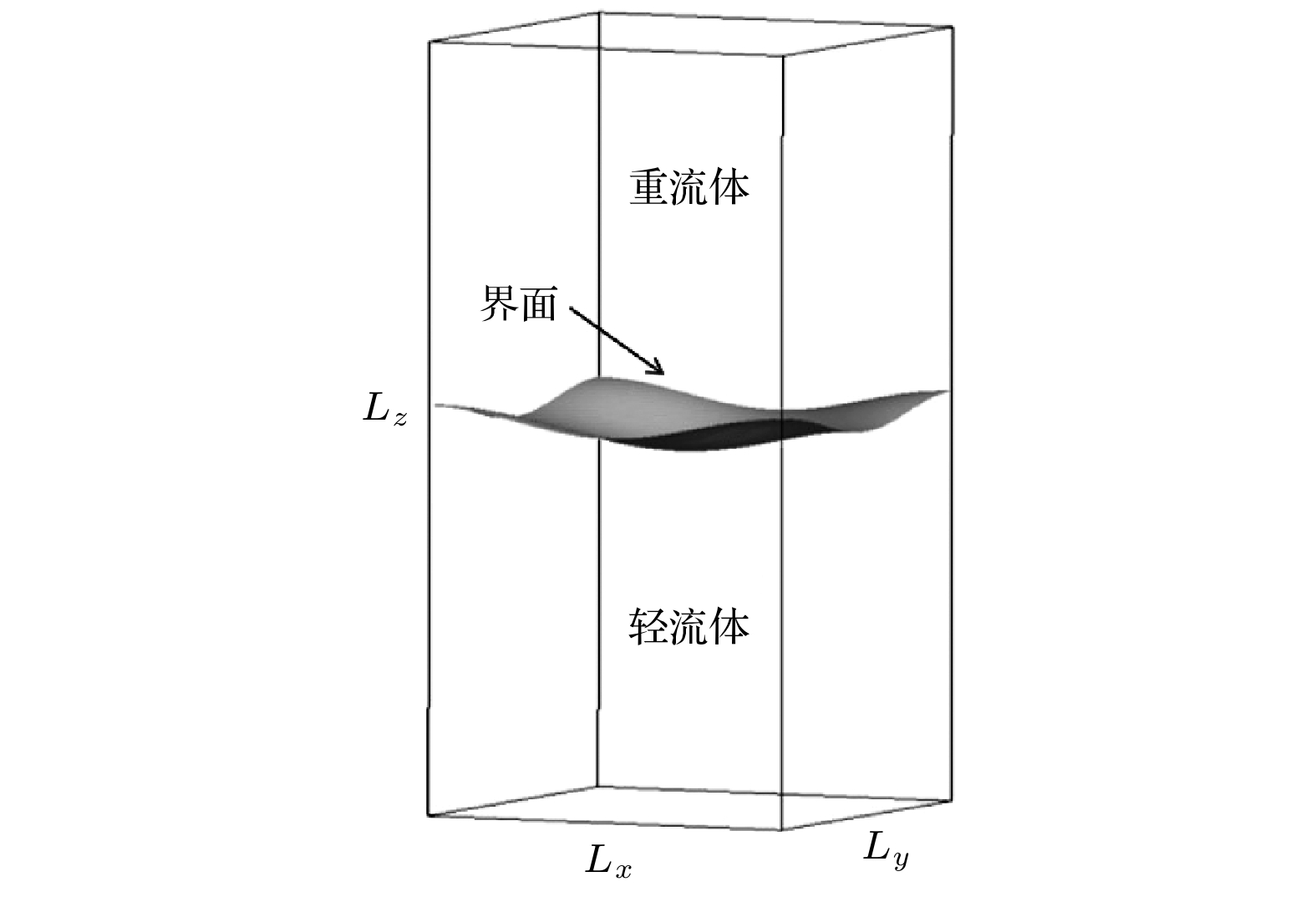
 下载:
下载:
